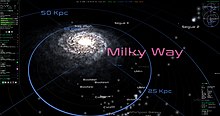Gaia Sky
 Saturn with its moons in Gaia Sky | |
| Original author(s) | Toni Sagristà Sellés |
|---|---|
| Developer(s) | Toni Sagristà Sellés |
| Initial release | 2014 |
| Stable release | 3.5.5-2 (4 October 2023).[1]
|
| Repository | codeberg |
| Written in | Java, GLSL |
| Operating system | Linux, macOS and Microsoft Windows |
| Size | Linux: 51 MB macOS: 105 MB Windows: 96 MB tar.gz package: 48 MB Source code: 27.1 MB |
| Type | Educational software Space simulator |
| License | Mozilla Public License |
| Website | zah |
Gaia Sky is an open-source astronomy visualisation desktop and VR program with versions for Windows, Linux and macOS. It is created and developed by Toni Sagristà Sellés in the framework of ESA's Gaia mission to create a billion-star multi-dimensional map of our Milky Way Galaxy, in the Gaia group of the Astronomisches Rechen-Institut (ZAH, Universität Heidelberg). Gaia Sky is a product of the outreach working group of the Gaia Data Processing and Analysis Consortium. The software is released under the Mozilla Public License.

The inner workings of Gaia Sky are described in detail in the paper Gaia Sky: Navigating the Gaia Catalog.[2]
Gaia Sky offers many advanced features like the stereoscopic (3D), planetarium and panorama renderers. It also works with virtual reality headsets through SteamVR,[3] is fully scriptable with Python[4] and features game controller support that makes it possible to operate it even with a racing wheel.[5]
Gaia Sky is used by ESA to aid in the video production of Gaia Data Releases.[6][7][8] A video made with Gaia Sky was also featured in the Astronomy Picture of the Day website.[9]
Data
[edit]
The installer packages of Gaia Sky contain the program but no data at all. In order to use Gaia Sky, at least a download of the base data package, containing the Solar System with low-resolution textures, is necessary. Gaia Sky offers a built-in download manager which connects to the servers at the Astronomisches Rechen-Institut in Heidelberg to fetch the desired datasets. The downloading and deploying processes are seamless to the user.
Several datasets are available, offering higher resolution textures, different cuts of the Gaia eDR3 catalog (up to 1.46 billion stars), other star catalogs such as the Hipparcos catalog, different galaxy maps (dust, HII regions, etc.), nebulae or extragalactic catalogs such as NBG[10] or Sloan Digital Sky Survey.
All datasets are specified in JSON files following a comprehensible and well documented format.[11]
External links
[edit]- Official website
- Gaia Sky source repository
- Official documentation
- Release list
- AUR package
- Flatpak (Flathub link)
- Version 3.0.0 teaser trailer
References
[edit]- ^ "Gaia Sky Downloads". Gaia Sky. Zentrum für Astronomie Heidelberg. Retrieved 18 October 2023.
- ^ Sagristà, Antoni; Jordan, Stefan; Müller, Thomas; Sadlo, Filip (Jan 2019). "Gaia Sky: Navigating the Gaia Catalog". IEEE Transactions on Visualization and Computer Graphics. 25 (1): 1070–1079. doi:10.1109/TVCG.2018.2864508. PMID 30130201. S2CID 52055837.
- ^ "Explore the Milky Way in VR with Gaia Sky". The Irish Times. IT. Retrieved 29 March 2021.
- ^ "Navigate the galaxy with Gaia Sky". Download CREW. Retrieved 29 March 2021.
- ^ "Using an iRacing setup for Gaia Sky". Youtube. Google. 15 January 2019. Retrieved 29 March 2021.
- ^ "Visualising the Gaia data with Gaia Sky". Gaia Cosmos. ESA. Retrieved 29 March 2021.
- ^ "Bridge of stars". Gaia Cosmos. ESA. Retrieved 29 March 2021.
- ^ "The acceleration of the Solar System with respect to the distant Universe". Gaia Cosmos. ESA. Retrieved 29 March 2021.
- ^ "Here comes the Sun". Astronomy Picture of the Day. ASD at NASA. Retrieved 9 December 2019.
- ^ "Nearby Galaxies Catalog". NBG. Retrieved 9 October 2019.
- ^ "Gaia Sky data formats". Gaia Sky documentation. Zentrum für Astronomie Heidelberg. Archived from the original on 23 October 2021. Retrieved 9 October 2019.
